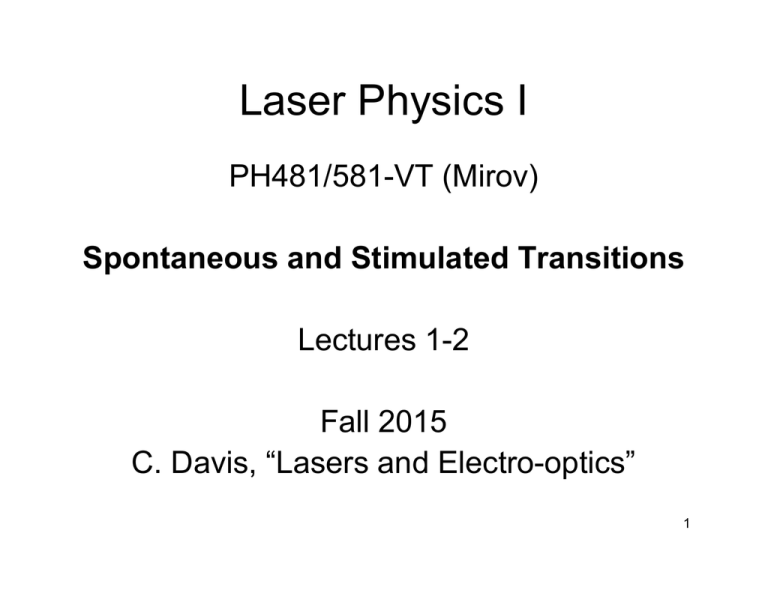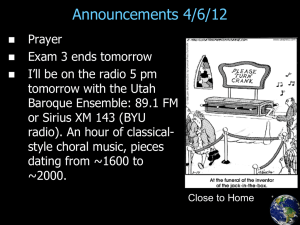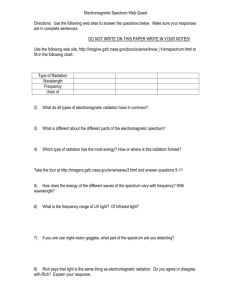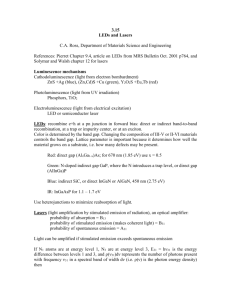Lecture Notes
advertisement

Laser Physics I PH481/581-VT (Mirov) Spontaneous and Stimulated Transitions Lectures 1-2 Fall 2015 C. Davis, “Lasers and Electro-optics” 1 A laser is an oscillator of optical frequencies that concentrates light energy in spatial, spectral and temporal domains. Excited state LOSER – Truthful Acronym- Light Oscillation by Stimulated Emission of Radiation. Inappropriate!!! LASER - Light Amplification by Stimulated Emission of Radiation Ground state 100% Mirror Gain medium Stimulated emission - Stimulated emission occurs when a traveling photon interacts with an exited atom. During the interaction, the atom will become de-excited and release a photon of the same frequency and 75 % Mirror direction of the incident photon. Lasers have 3 parts: 1. Gain medium – a place for stimulated emmision to occur (crystal, gas, etc.) 2. Positive feedback – means for oscillation (mirrors, diffraction grating, etc.) 3. Source of energy – an incoming energy source which keeps more atoms in the excited state than in the ground state. First Solid State Ruby Laser (Dr. Ted Maiman, Hughes Aircraft 1960) A laser is an oscillator that operates at optical frequencies. These frequencies of operation lie within a spectral region that extends from the very far infrared to the vacuum ultraviolet (VUV) or soft-X-ray region. At the lowest frequencies at which they operate, lasers overlap with the frequency coverage of masers (mm scale). Athmospheric transmission 0.2 Co:MgF2 Cr:Zn/CdSe Fe:ZnSe/ CdZnTe Ti:S/Cr:LiSAF 0.5 1 Cr:YAG 2 Tm:laser 5 10 20 µm Molecular frequencies UV –Middle infrared part of electromagnetic spectrum and tuning ranges of the most common solid state lasers 4 HISTORY A laser is an oscillator of optical frequencies that concentrates light energy in spatial, spectral and temporal domains. In 1917 Albert Einstein, in his paper On the Quantum Theory of Radiation, laid the foundation for the invention of the laser and its predecessor, the maser, by introducing the concepts of probability coefficients (later to be termed 'Einstein coefficients') for the absorption, spontaneous emission, and stimulated emission of electromagnetic radiation. A little bit of history 1917 Albert Einstein. Basic physics of light emission and absorption by atoms and molecules 1928 Rudolph Walther Landenburg confirmed the existence of stimulated emission and negative absorption. 1939, Valentin Fabrikant predicted the actual use of stimulated emission in gas discharges to amplify light. Observation and patenting of negative absorption in 1944. 1954 James Gordon, Herbert Zeigel and Charles Townes proposed and developed maser, a microwave amplifier using stimulated emission. 1954 Aleksandr Prokhorov and Nikolai Basov independently proposed and developed maser. 1960 Theodore H. Maiman –first Ruby laser. 1964, Nikolai Basov, Charles Townes, and Aleksandr Prokhorov received the Nobel Prize for "fundamental work in the field of quantum electronics, which has led to the construction of oscillators and amplifiers based on the maser-laser principle. 6 Academician T. Basiev ZrO2 Lebedev Physics Institute Academician A. Prokhorov explains how laser works Academician V. Osiko inventor of Cubic Gems CubicZirconia Zirconia Gems Light and Electromagnetic Waves Light is one form of electromagnetic radiation. Electromagnetic radiation, which transports energy from point to point at the velocity of light, can be described in terms of both wave and particle "pictures" or "models." This is the famous "wave-particle" duality of all fields or particles in our model of the Universe. In the electromagnetic-wave picture, waves are characterized by their frequency , wavelength , and the velocity of light c, which are inter-related by c = . A propagating electromagnetic wave is characterized by a number of field vectors, which vary in time and space. These include the electric field E (volts/m), the magnetic field H (amps/m), the displacement vector D (coulombs/m2), and the magnetic flux density B (tesla). For a complete description the polarization state of the wave must also be specified. Linearly polarized waves have fixed directions for their field vectors, which do not re-orient themselves as the wave propagates. Circularly or elliptically polarized waves have field vectors that trace out circular, or elliptical , helical paths as the wave travels along. 8 Particle Picture of Light ln the particle picture, electromagnetic energy is carried from point to point as quantized packets of energy called photons. The energy of a photon of frequency is h , where h is Planck's constant, namely 6.626 x10-34 J s. Photons have zero mass, and travel at the velocity of light, but carry both linear and angular momentum. The linear momentum of a photon of wavelength . is p = h /., and the angular momentum depends on the equivalent polarization state of the corresponding wave. Circularly polarized photons have angular momentum h /(2 ) = Our everyday experience of "light" generally encompasses only the small part of the electromagnetic spectrum to which the human eye is sensitive, a wavelength range running roughly from 400 nm to 700 nm. The full electromagnetic spectrum, going from low to high frequencies, is divided into radiowaves (0-1 GHz), microwaves (1-300 GHz), infrared waves (of wavelength = 0.7-1000 m; 300 GHz to 430 THz), visible light (= 400- 700 nm), ultraviolet light (= 10-400 nm), X-rays (= 0.1-10 nm), and rays (< 0.1 nm). 9 Some basic electromagnetic theory 10 11 The polarization state of an electromagnetic wave 12 13 14 15 16 17 18 Bands in crystalline solids 19 Bands in crystalline solids 20 Basic laser structure 21 Amplifier of optical frequencies 22 Spontaneous Emission 23 24 The lineshape function, g() 25 Lineshape function. Example Hz s 26 27 Stimulated Emission 28 The relation between energy density and intensity 29 30 31 32 33 Intensity of a Beam of Electromagnetic Radiation in Terms of Photon Flux 34 Black-Body Radiation 35 36 37 38 39 40 Relation Between the Einstein A and B Coefficients 41 Einstein relations 42 The effect of level degeneracy 43 Ratio of Spontaneous and Stimulated Transitions 44 45



